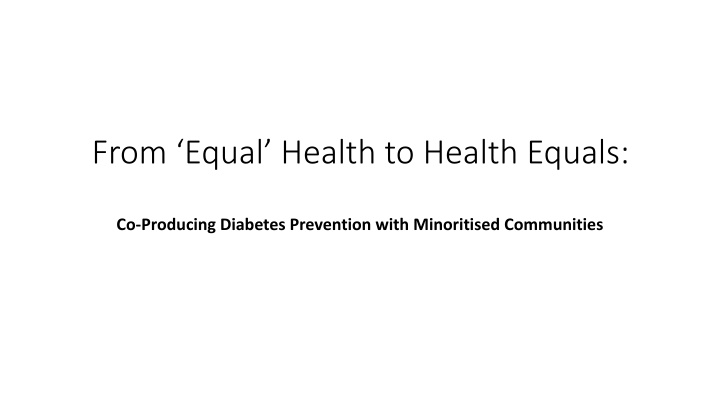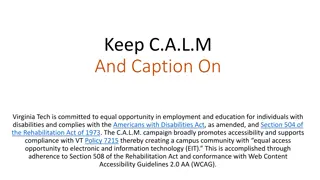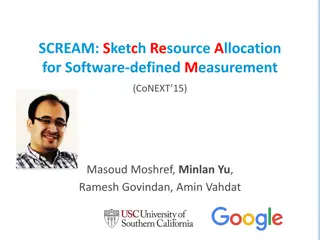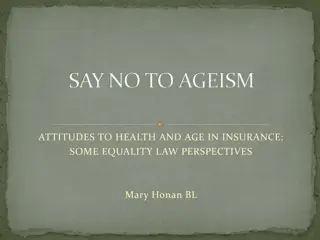
Co-Producing Diabetes Prevention with Minoritised Communities
Explore the challenges and disparities in diabetes care for minoritised communities in Barbados, the UK, and the USA. Uncover the root causes of health inequality in universal health systems and the impact of biomedical marginalisation. Discover how systemic factors, health environment, stigmatization, and mistrust contribute to poor outcomes despite free healthcare access.
Download Presentation

Please find below an Image/Link to download the presentation.
The content on the website is provided AS IS for your information and personal use only. It may not be sold, licensed, or shared on other websites without obtaining consent from the author. If you encounter any issues during the download, it is possible that the publisher has removed the file from their server.
You are allowed to download the files provided on this website for personal or commercial use, subject to the condition that they are used lawfully. All files are the property of their respective owners.
The content on the website is provided AS IS for your information and personal use only. It may not be sold, licensed, or shared on other websites without obtaining consent from the author.
E N D
Presentation Transcript
From Equal Health to Health Equals: Co-Producing Diabetes Prevention with Minoritised Communities
Congruencies in Diabetes Care Challenges: Congruencies in Diabetes Care Challenges: Free is not enough, and numbers don t Free is not enough, and numbers don t always count (what matters) always count (what matters) *WHO figures, pop between ages 20-79 (Source: IDF, Diabetes Atlas.) Barbados Universal Health Care/ mixed health economy providers (65% public/35% private) Common Ground 14% prevalence of diagnosed diabetes* Universal healthcare coverage of citizens/members free at the point of delivery. UK Congruencies in Diabetes Care Challenges Populations of African American and African Caribbean heritage with shared histories of enslavement and traumatic racism (England & Wales) Kaiser Permanente N. CA Division Pre-paid health plans Diabetes treatments covered Diabetes prevention services covered Minoritised members experience higher prevalence and worse outcomes NHS/Private sector (100% public/13% private) High and growing rates of Type 2 diabetes among covered populations; 6.3% prevalence of diagnosed diabetes* Diabetes care, treatments and prevention services included in coverage; USA in general Diabetes and pre-diabetes diagnosis and clinical management highly quantified; Mixed health economy (44.2% public/68.4% private/8.6% uninsured) But NB: Insured and uninsured also have out-of-pocket spending (other than premiums) including coinsurance, deductibles, services not covered by insurance; and payments from the uninsured for health care goods and services. Among all individuals, out-of- pocket spending was $433 billion (10.7% of total HCE) in 2021. Biomedically marginalised communities experience greater prevalence and worse outcomes for diabetes despite nominally equal access to care. 10.7% Diagnosed diabetes prevalence* What does biomedically marginalised mean? Refers to communities, whether majority or minority, that are un- or under- represented in the normative models for health, health research and health provision in their home healthcare systems.
Why isnt Free enough? Unearthing the Roots of Health Inequality in Universal Health Systems Our planned study will allow us to look at: Systemic factors in the provision of preventive interventions, e.g. under- funding, pressure to quantify, and drive to digital health Health environment factors: time poverty, scarcity of clinical professionals Biomedical marginalisation: community under-representation; community divergence from normative embodiment; biased diagnostic, risk modelling, and health economic tools. Stigmatization: too fat and too lazy Mistrust and miscommunication: persistence of history, and power of stereotypes and assumptions
The Study Sites: Building an innovative analytical mesh Barbados UK mixed economy of healthcare 17.5% population over 40 have Type 2; diabetes 3rd highest cause of death, and costs $43M in 2021 Diabetes medications provided free, but outcomes poor. (Under-resourced) universal health cover for citizens providers (65% public/35% private) Universal healthcare system (marginally under-resourced) Diabetes medications provided free, but outcomes poorer than expected 8.2%prevalence of diagnosed diabetes 2021 Practical effect: universal care free at point of delivery Diabetes meds provided at low cost for members Integrated managed care health system based on pre-paid health plans and insurance (with deductibles and co-pays moderating service uptake) 4.6M health plan members; 21 Hospitals; 269 Medical offices; 9580 Physicians; 86,283 Employees c. 2022. Kaiser Permanente USA Mixed economy of healthcare providers 28.5M diabetics, 2019 $380B spent on diagnosed diabetic health 2021; 13.65 prevalence of diagnosed diabetes 2021
Managing complexity: Yikes! The 4 Phases The Three Intervention Anchors The Through-Strands Three health systems Three communities Five disciplines (History, Health Services Research, Health Economics, Clinical Research, Digital Healthcare) Seven collaborating entities/organisations Generate Innovate Evaluate Communicate N. California= Community holistic Big Data underpinning community leadership, corporate collaboration Barbados = Conventional interventions, novel spaces and capacity building design West Midlands = Digital Health, community design, co- producing sustainability History as laboratory for policy Elevating unheard voices and stories Debunking ahistorical and stigmatising assumptions Building community capacity






















